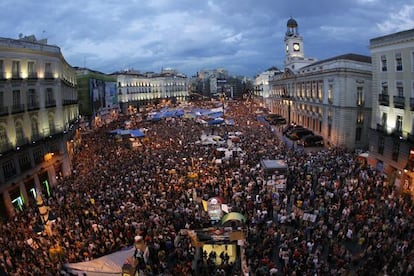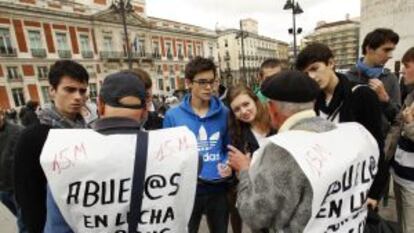The struggle for square one: police and 15-M protesters draw battle lines
Authorities vow to stop demonstrators from retaking Sol on first anniversary

As the first anniversary of the 15-M protest movement approaches, both demonstrators and the police are getting ready to record almost every aspect of the event with mobile devices, to use as potential evidence in court should violence erupt. This "war of the cameras" is further proof of the degree to which all parties involved are taking precautions - a lesson learned from previous face-offs between demonstrators and law enforcement officers in the months following May 15, 2011.
A year after a bunch of youthful activists occupied Madrid's Puerta del Sol square, to protest against Spain's economic crisis and the political class's collective inability to deal with it - unwittingly spawning a global movement that includes Occupy Wall Street in the US - the government is planning to triple the amount of riot police in the capital this weekend. The ruling Popular Party (PP) has insisted that it will not allow another long-term campout at the square like last year, yet it knows that forcibly clearing out a massive sit-in could place it in a delicate situation in terms of public opinion.
The government delegate, Cristina Cifuentes, has said that the authorities want to guarantee 15-M's right to demonstrate, as long as they do not curtail the rights of other citizens. At the same time, she underscored that no camps will be allowed in Sol and that police will act swiftly if the deadlines are not respected. The approved schedule allows for a five-hour protest on May 12, and 10-hour protests on May 13, 14 and 15.
But the indignados (literally "the indignant ones") have their hearts set on reconquering their sentimental homeland, and they are ready to fight for control of the square.
This focus on Puerta del Sol - which represents the social heart of Madrid, houses the seat of the regional government and is located at the geographical center of Spain - is a reminder that the square has acquired symbolic status in the months since May 15 of last year. When, on October 15, cities in 82 countries held similar demonstrations following the Madrid example, Sol suddenly became the most significant Spanish export of the 21st century so far.
Those who were there are still keen to talk about what it was like during those heady days in May, which some observers quickly likened to the French protests of 1968.
The 15-M movement turned the Puerta del Sol into a monument"
At first, Andrés Vázquez has trouble recalling where everything used to be, but then the memories come flooding back. "We set up a vegetable patch inside the central fountain, and over there where you see Sponge Bob Squarepants [an entertainer wearing a costume at the far end of the square], there were a few stands," he says.
Andrés was one of the people who stayed the longest during the campout. He would record videos of how things worked and upload them onto the internet. A year on, his emotional link to this place is not broken. "This is a symbol; a reference point; square one."
"The 15-M movement turned Puerta del Sol into a monument," says Jorge Lozano, a professor of semiotics at Complutense University. In his view, it became a spot that "radiated non-verbalized passions" out to the rest of the world.
A member of the movement's analysis committee explains that 15-M "extends far beyond the square, but it's true that collectives need liturgies. We created a myth, a place that captured the sense of political belonging to something different than the existing movements, and the government has chosen to respond with another myth, that of Sol as an economic and tourist macro-center. This pits us against each other in a symbolic struggle."
In this battle of images, the grassroots activists seem to have an advantage over the government, whose delegate they have portrayed as a control freak. "I am not fixated with Sol," replies Cifuentes. "This year there were 120 demonstrations there, and we only recommended changing the itinerary of one because there were three coming together at the same time. We don't want to armor-plate the square, but all citizens have a right to use it, it cannot be there for the exclusive use of a specific collective."
Grandfolks of the protest

Another group of people occupied Puerta del Sol for a while on May 7, just four days before the official 15-M events are scheduled to kick off. This group significantly surpassed the average 15-M protester - both in age and in ailments. They are known as the grandfolks of the protest movement, as written on their vests, which they cut out of potato sacks. These older protesters were once active in anti-Franco movements, labor union struggles and neighborhood associations, and come mostly from working class neighborhoods.
On May 7, five of these 15-M seniors - there are around 50 of them in total, according to group member Lázaro Sola - set up a table in Puerta del Sol to collect signatures to start a popular legislative initiative demanding that the state cough up the money that retirees lost when pensions were frozen in 2011.
"It's important for people to realize that problems are not personal, but rather social and political," says Juana León, 67.
Tu suscripción se está usando en otro dispositivo
¿Quieres añadir otro usuario a tu suscripción?
Si continúas leyendo en este dispositivo, no se podrá leer en el otro.
FlechaTu suscripción se está usando en otro dispositivo y solo puedes acceder a EL PAÍS desde un dispositivo a la vez.
Si quieres compartir tu cuenta, cambia tu suscripción a la modalidad Premium, así podrás añadir otro usuario. Cada uno accederá con su propia cuenta de email, lo que os permitirá personalizar vuestra experiencia en EL PAÍS.
¿Tienes una suscripción de empresa? Accede aquí para contratar más cuentas.
En el caso de no saber quién está usando tu cuenta, te recomendamos cambiar tu contraseña aquí.
Si decides continuar compartiendo tu cuenta, este mensaje se mostrará en tu dispositivo y en el de la otra persona que está usando tu cuenta de forma indefinida, afectando a tu experiencia de lectura. Puedes consultar aquí los términos y condiciones de la suscripción digital.








































